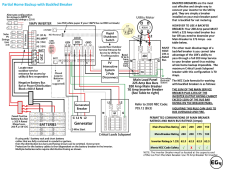nuke
New Member
Per this diagram, they state that the critical loads subpanel breaker must be no bigger than 70 amps. I don't get why - as long as the critical loads subpanel is rated for 200a, and the wiring from the 18kpv to the critical loads subpanel can support 200a, won't it be fine?
My reasoning:
1) My critical loads subpanel right now is a 225a bussed MLO panel that I don't want to replace since it has a lot of breaker slots
2) Theoretically, the inverter + main loads panel could provide over 100a to the critical loads subpanel together, so why limit to 70a if the wiring and panel supports it?

My reasoning:
1) My critical loads subpanel right now is a 225a bussed MLO panel that I don't want to replace since it has a lot of breaker slots
2) Theoretically, the inverter + main loads panel could provide over 100a to the critical loads subpanel together, so why limit to 70a if the wiring and panel supports it?

Last edited:


